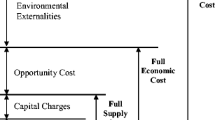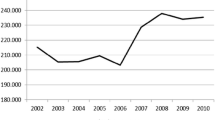Abstract
The aim of this paper is to compare the supply-side and demand-side approaches for assessing the scarcity rents of irrigation water. The results obtained from the case study confirm the expectation that the demand-side rationale provides the lower bound estimate of water scarcity rents. Specifically, a hypothetical elimination of water scarcity brings extra benefits to the local farmers, but these benefits cannot compensate the costs of the backstop technology which provide such extra water. Therefore, the lost opportunities, in terms of income forgone due to water scarcity, cannot legitimize supply-side approaches alone. A “soft” sensitivity analysis was included to examine the robustness of such a cost-effective property, while the policy implications of the results are also examined.



Similar content being viewed by others
Notes
A groundwater may or may not necessarily be classified as a non-renewable resource depending on the specific characteristics that describe its replenish.
Other, non-normative and less utilitarian formulations concerning the PU objectives are also possible. This point was brought to our attention by the anonymous reviewer.
References
Amit R, Ramachandran P (2010) A fair contract for managing water scarcity. Water Resour Manag 24(6):1195–1209
Angelakis A, Gikas P (2014) Water reuse: overview of current practices and trends in the world with emphasis on EU states. Water Utility Journal 8:67–78
Berbel J, Viaggi D, Manos B (2009) Estimating demand for irrigation water in European Mediterranean countries through MCDM models. Water Policy 11:348–361
Bithas K, Kollimenakis A, Maroulis G, Stylianidou Z (2014) The water framework directive in Greece. Estimating the environmental and resource cost in the water districts of western and Central Macedonia: methods, results and proposals for water pricing. Procedia Economics and Finance 8:73–82
Brandes OM, Brooks DB, Gurman S (2009) Why a water soft path, and why now. In: Brooks D, Brandes O, Gurman S (eds) Making the most of the water We have: the soft path approach to water management. Earthscan, London, pp 3–21
Cabezas F (2012) The European water framework directive: a framework? Int J Water Resour Dev 28:19–26
Carlson G, Zilberman D, Miranowski J (1993) Agricultural and environmental resource economics. Oxford University Press, New York
Coleman E (2009) A comparison of demand-side water management strategies using disaggregate data public works. Manag Policy 13:215–223
Conrad J (1999) Resource economics. Cambridge University Press, Cambridge
Dagnino M, Ward FA (2012) Economics of agricultural water conservation: empirical analysis and policy implications. Int J Water Resour Dev 28:577–600
Dawadi S, Ahmad S (2013) Evaluating the impact of demand-side management on water resources under changing climatic conditions and increasing population. J Environ Manag 114:261–275
Easter KW, Liu Y (2007) Who pays for irrigation: cost recovery and water pricing? Water Policy 9:285–303
EEA (2009) Water resources across Europe—confronting water scarcity and drought. European Environment Agency, Copenhagen
Fisher A (1981) Resource and environmental economics. Cambridge University Press, Cambridge
Galioto F, Raggi M, Viaggi D (2013) Pricing policies in managing water resources in agriculture: an application of contract theory to unmetered water. Water 5:1502
Gleick PH (2000) The changing water paradigm a look at twenty-first century water resources development. Water Int 25:127–138
Gleick PH (2003) Global freshwater resources: soft-path solutions for the twenty-first century. Science 302:1524–1528
Gómez CM, Pérez-Blanco CD (2014) Simple myths and basic Maths about greening irrigation. Water Resour Manag 28:4035–4044
Grafton Q, Pendleton L, Nelson H (2001) A dictionary of environmental economics, science, and policy. Edward Elgar, Cheltenham
Graveline N (2016) Economic calibrated models for water allocation in agricultural production: a review. Environ Model Softw 81:12–25
Griffin R (2001) Effective water pricing. J Am Water Resour Assoc 37:1335–1348
Griffin R (2006) Water resource economics: the analysis of scarcity, policies, and projects. MIT Press, Cambridge
Griffin R (2012) The origins and ideals of water resource economics in the United States. Ann Rev Resour Econ 4:353–377
Howe C (1979) Natural resource economics. John Wiley, New York
Jaeger WK et al (2013) Toward a formal definition of water scarcity in natural-human systems. Water Resour Res 49:4506–4517
Jaghdani TJ, Brümmer B, Barkmann J (2012) Comparison of methods for the valuation of irrigation water: case study from Qazvin, Iran. Irrig Drain 61:375–385
Job C (2010) Groundwater economics. CRC Press, Boca Raton
Kampas A, Petsakos A, Vasilaki A, Stefopoulou A (2014) Rapid assessment of irrigation full cost: an application for the Pinios local Organization for Land Reclamation, Greece. Water Resources and Economics 6:58–73
Karamouz M, Szidarovszky F, Zahraie B (2003) Water resources systems analysis. Lewis Publishers, London
Koundouri P, Xepapadeas A (2003) A new methodology for measuring groundwater scarcity: theory and application. In: Koundouri P, Pashardes P, Swanson T, Xepapadeas A (eds) The economics of water Management in Developing Countries: problems, principles, and policies. Edawrd Elgar, Cheltenham, pp 134–156
Kristensen P, Solheim A, Austnes K (2013) The water framework directive and state of Europe’s water. Eur Water 44:3–10
Krulce DL, Roumasset JA, Wilson T (1997) Optimal management of a renewable and replaceable resource: the case of coastal groundwater. Am J Agric Econ 79:1218–1228
Latinopoulos D (2008) Estimating the potential impacts of irrigation water pricing using Multicriteria decision making modelling. An application to northern Greece. Water Resour Manag 22:1761–1782
Latinopoulos D (2014) Using a choice experiment to estimate the social benefits from improved water supply services. J Integr Environ Sci 11:187–204
Livernois J, Martin P (2001) Price, scarcity rent, and a modified r per cent rule for non-renewable resources. Can J Econ 34:827–845
Loehman E (2008) Pricing for water conservation with cost recovery. Water Resour Res 44(8). doi:10.1029/2008WR006866
Loukas A, Mylopoulos N, Vasiliades L (2007) A modeling Syste for the evaluation of water resources management strategies in Thessaly, Greece. Water Resour Manag 21(10):1673–1702
Maggioni E (2015) Water demand management in times of drought: what matters for water conservation. Water Resour Res 51:125–139
Makropoulos C, Mimikou M (2012) Innovative approaches to halt desertification in Pinios: piloting emerging technologies- a monograph. National Technical University of Athens. School of Civil Engineering, Athens
Markandya A, Perelet R, Mason P, Taylor T (2001) Dictionary of environmental economics. Earthscan, London
Massarutto A (2003) Water pricing and irrigation water demand: economic efficiency versus environmental sustainability. Eur Environ 13:100–119
Massarutto A (2015) An economic approach to water scarcity. In: Antonelli M, Greco F (eds) The water We eat: combining virtual water and water footprints. Springer, Heidelberg, pp 175–186
Mesa-Jurado MA, Martin-Ortega J, Ruto E, Berbel J (2012) The economic value of guaranteed water supply for irrigation under scarcity conditions. Agric Water Manag 113:10–18
Moncur J, Pollock R (1988) Scarcity rents for water: a valuation and pricing model. Land Econ 64:62–72
Olmstead S (2010) The economics of managing scarce water resources. Rev Environ Econ Policy 4:179–198
Olmstead S, Stavins R (2009) Comparing price and nonprice approaches to urban water conservation. Water Resour Res 45(4). doi:10.1029/2008WR007227
Riegels N, Jensen R, Bensasson L, Banou S, Møller F, Bauer-Gottwein P (2011) Estimating resource costs of compliance with EU WFD ecological status requirements at the river basin scale. J Hydrol 396:197–214
Rijsberman F (2006) Water scarcity: fact or fiction? Agric Water Manag 80:5–22
Saltelli A, Tarantola S, Campolongo F, Ratto M (2004) Global sensitivity analysis for importance assessment. Sensitivity analysis in practice. John Wiley & Sons, Ltd, Chichester
Santos Pereira L, Cordery I, Iacovides I (2009) Coping with water scarcity: addressing the challenges. Coping with water Scarcity: addressing the challenges. Springer, New York
Tsakiris G (2015) The status of the European waters in 2015: a review. Environmental Processes 2(3):543–557
Tsiros E, Domenikiotis C, Dalezios N (2009) Sustainable production zoning for agroclimatic classification using GIS and remote sensing. Quarterly Journal of the Hungarian Meteorological Service 113:55–68
Tsur Y (2005) Economic aspects of irrigation water pricing. Canadian Water Resources Journal 30:31–46
Tsur Y, Zemel A (2005) Scarcity, growth and R&D. J Environ Econ Manag 49:484–499
Tsur Y, Dinar A, Doukkali R, Roe T (2004) Irrigation water pricing: policy implications based on international comparison. Environ Dev Econ 9:735–755
Van Kooten G, Butle E (2000) The economics of nature: managing biological assets. Blackwell, Oxford
Ward F, Pulido-Velazquez M (2009) Incentive pricing and cost recovery at the basin scale. J Environ Manag 90:293–313
WATECO (2003) Economics and the environment–the implementation challenge of the water framework directive vol common implementation strategy for the water framework directive (2000/60/EC). EC, Luxembourg
Wu W, Maier HR, Simpson AR (2010) Single-objective versus multiobjective optimization of water distribution systems accounting for greenhouse gas emissions by carbon pricing. J Water Resour Plan Manag 136:555–565
Acknowledgements
The authors greatly appreciate the financial support of the research project LIFE08 ENV/GR/000570: HydroSense “Innovative Precision Technologies for Optimized Irrigation and Integrated Crop Management in a Water-limited Agro-system”. Also, we kindly appreciate the useful comments and suggestions we received from the Associate Editor and the two anonymous reviewers.
Author information
Authors and Affiliations
Corresponding author
Additional information
Highlights
1. The paper compares two different approaches for assessing scarcity rents, namely the demand-side and the supply-side alternatives.
2. The demand-side approach provides the lower bound estimates for scarcity rents, while the supply-side approach gives the upper bound these estimates.
3. Given that the appropriate estimation of water scarcity rents will determine the full cost assessment and the resulting water prices, public utilities should not uncritically rely only on supply-side approaches.
Rights and permissions
About this article
Cite this article
Kampas, A., Rozakis, S. On the Scarcity Value of Irrigation Water: Juxtaposing Two Market Estimating Approaches. Water Resour Manage 31, 1257–1269 (2017). https://doi.org/10.1007/s11269-017-1574-0
Received:
Accepted:
Published:
Issue Date:
DOI: https://doi.org/10.1007/s11269-017-1574-0




